Rollo was a well-known Viking leader who lived between the 9 th and 10 th centuries AD. He is best-known for becoming the ruler of Normandy and is therefore sometimes referred to as the first Duke of Normandy . As a matter of fact, Rollo is not known to have used this title. Instead, it was one of his descendants who began to use the ‘Duke of Normandy’ title officially. In modern times, Rollo has become a part of popular culture, thanks to his depiction by the English actor Clive Standen in the television series Vikings. It must be pointed out, however, that the Rollo of the series is only loosely based on the real Viking leader and is, therefore, a largely fictional account of this historical figure.
Rollo is known also as Rollon (in French), Rou (in Norman), and Hrólfr (in Old Norse). There are various sources written during the Middle Ages about Rollo’s life. Most of these sources were written by Norwegian or Danish writers. A biography of Rollo is also found in the official history of the Normans, which was written by Dudo of Saint-Quentin during the late 10 th century AD. In 986 AD, Dudo, who was a canon of Saint-Quentin, was sent by Count of Vermandois to the Normans, in order to seek their help against Hugh Capet, the first King of the Franks from the Capetian dynasty . Subsequently, Dudo was employed by Richard I, Rollo’s grandson, to write a history of the Norman dukes. Between 1015 and 1026 AD, Dudo completed his De moribus et actis primorum Normanniae ducum (“Concerning the Customs and Deeds of the First Dukes of the Normans”).
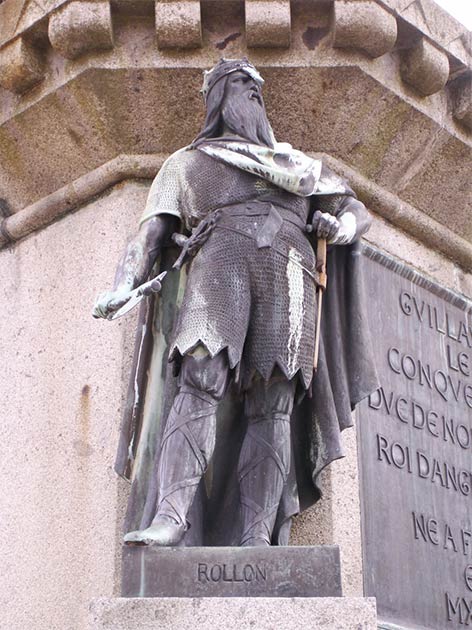
Statue of Rollo, Falaise, France. ( CC BY-SA 2.5 )
Rollo the Viking and His Rise to Power
Rollo is believed to have been born around 860 AD, though his place of birth is unclear. Although it is clear that Rollo was born in Scandinavia it is not clear whether he was from Norway or Denmark. According to Dudo, for instance, Rollo is said to have hailed from the Alps-surrounded area of Dacia in Eastern Europe. Some have interpreted this to mean Denmark. Other sources, however, claim that Rollo was from Norway. In Snorri Sturluson’s Heimskringla, for instance, there is a story about a Norwegian Viking called Rolf Ganger, whom some have identified as Rollo. Incidentally, the name ‘Rolf Ganger’ means ‘Rolf the Walker’, and this epithet was given to him because he was “of so stout a growth that no horse could carry him, and wheresoever he went he must go on foot”. This Rolf Ganger also appears in other Norwegian-Icelandic sources, such as the Latin Historia Norvegiae , and the Fagrskinna.
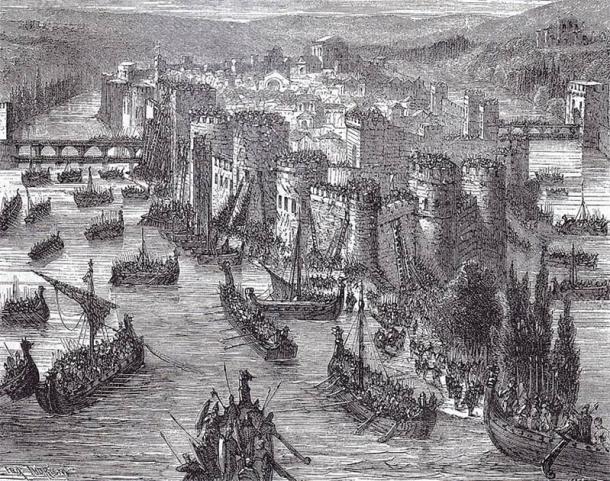
Viking Ships besieging Paris. ( Public domain )
Rollo may have been Danish or Norwegian, but he was certainly expelled from his homeland. According to Dudo, there was a king of Dacia who was antagonistic towards Rollo’s family. When Rollo’s father (who, like the king, is unnamed) died, he was succeeded by his two sons, Rollo and Gurim. The king saw the death of Rollo’s father as an opportunity to seize his lands, and to “take revenge on the sons for the deeds of the father”. Eventually, the king attacks Rollo, but is unable to defeat him. As a result, the war dragged on for a year. The king realised that he would not be able to conquer Rollo by force, so he resorted to deceit, and pretended to make peace with his enemy. Rollo welcomed the peace-making offer, being completely unaware of the king’s intended treachery. When night fell, the king attacked Rollo again, and set up an ambush near the walls of the city. The king pretended to flee from Rollo and once the latter was out of his city, the trap was sprung. Rollo found himself caught between two armies, and many of his men, including his brother, were killed. Fortunately, Rollo managed to escape from Dacia and sailed to the island of Scania with his remaining men.
The story of banishment is also found in the Heimskringla. According to Sturluson, Rollo was the son of Earl Ragnvald, a close friend of the Norwegian king, Harald Fairhair , and Hild, a daughter of Rolf Nefia. Rollo had a brother called Thorer, as well as several half-brothers. When Rollo grew up, he became a formidable Viking. One summer, Rollo raided the coast of Viken. Harald, who so happened to be in Viken at that time, heard of the raid and was enraged, as he had forbidden his men to plunder within the boundaries of Norway. The king summoned a Thing, or an assembly, and Rollo was declared an outlaw. Rollo accepted his punishment and sailed westwards, where he continued his raids.
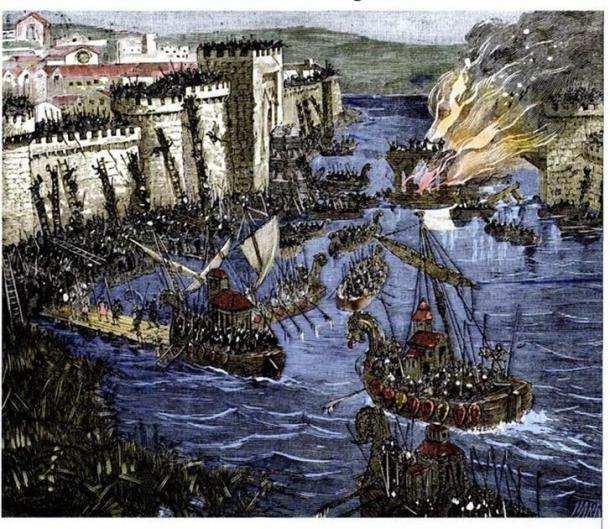
Viking attack on Paris in 845 ( Public domain )
Rollo and The Viking’ Raids on Paris, France
Rollo lived during a time in European history called the ‘ Viking Age ’. This era lasted from around the end of the 8 th century AD to the 11 th century AD. During the Viking Age, Scandinavian raiders, like Rollo, frequently made their fortunes by plundering coastal sites. Although the British Isles suffered the most from these raids, the Vikings also set foot on the European mainland, and even reached as far away as eastern Europe. The Vikings, however, did not have a great impact on continental Europe, and their activities in eastern Europe seem to have been less violent than in the West. In the British Isles and in eastern Europe, the Vikings eventually became settlers. In mainland Europe, on the other hand, the Vikings were not so successful in establishing settlements, with the exception of Rollo.
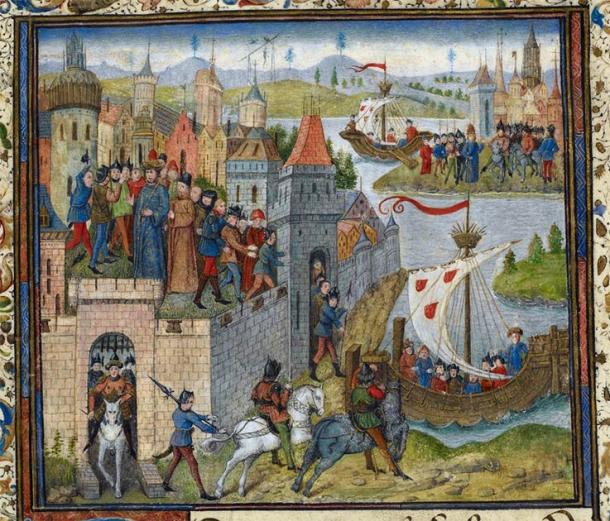
Detail of a miniature of the arrival of Duke Rollo in Normandy, with the city of Rouen on the left. ( Public domain )
Whilst Rollo founded Normandy, he was certainly not the first Viking to raid France, or West Francia as it was then known. Viking raids on France are known to have occurred as early as the end of the 8 th century AD. As France was part of the Carolingian Empire , the emperor, Charlemagne, built coastal defences to protect his realm. Although these defences reduced the number of Viking raids, they did not stop them completely. One of the most famous Viking raids was the Siege of Paris in 845 AD. That year, about 5000 Vikings laid siege to Paris. The Vikings arrived in Paris via the Seine on board 120 ships led by a chieftain named Reginherus or Ragnar. This chieftain is sometimes identified as Ragnar Lothbrok , a figure from the legendary Norse sagas. Four years before the siege, Ragnar was given some land in Flanders by the king, Charles the Bald. Soon, however, Ragnar lost the king’s favour, and was forced to return his land to him.
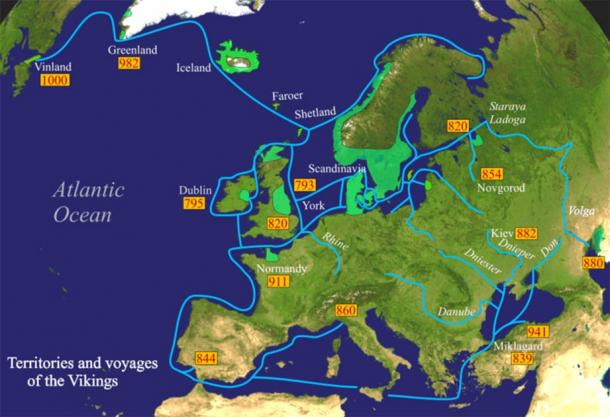
Important European Vikings Voyages (Bogdangiusca / CC BY-SA 3.0 )
In retaliation, Ragnar decided to launch a raid on France. The Vikings sailed up the Seine, and plundered Rouen on their way to Paris. Charles was determined to defend the Abbey of Saint-Denis , to the north of Paris, so he assembled his army, divided them into two garrisons, and stationed them on both banks of the Seine. Ragnar attacked the smaller of the two garrisons, defeated them, and even managed to take some prisoners. After this victory, the Vikings continued their journey, and reached Paris on Easter. Ragnar and his men entered the city and sacked it. The Vikings only left Paris after a ransom of 7000 livres of silver and gold were paid to them. As Ragnar withdrew, he plundered several other Frankish sites.
In the decades that followed, the Vikings carried out further raids on West Francia. Paris itself was attacked three more times during the 860s. On each occasion, the Vikings only left after they sacked the city, or were paid off. At the same time, however, the Franks took measures to deter these raids. In 864 AD, for example, two footbridges crossing the Seine to Paris (located on the Île de la Cité) were built. Moreover, the city was further fortified to better resist the Vikings. These defensive measures were put to the test in 885 AD, when the Vikings attacked Paris again.
Although Paris was well fortified, the kingdom of West Francia had grown weaker in the years leading up to 885 AD. For example, Charles died in 877 AD, and was succeeded by a number of short-lived kings. The Vikings saw the weakness of the Franks as an opportunity to attack Paris again. The Vikings, led by Sigfred, Sinric, and Rollo, initially issued their demands to the king, Charles the Fat (who was also a Holy Roman emperor). When these demands were not met, the Vikings launched an attack on Paris.
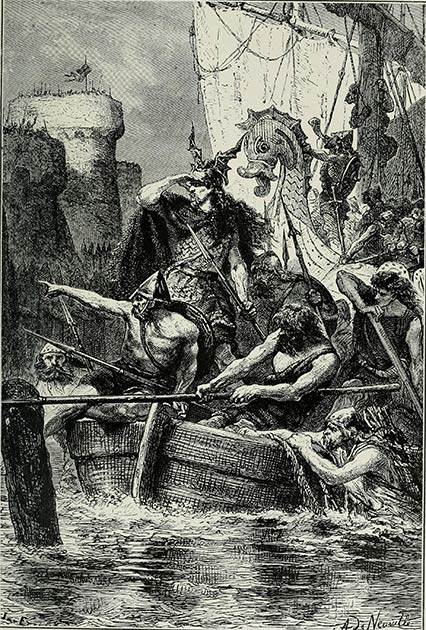
Viking attack in France. (Internet Archive Book Images / Public domain )
The defence of Paris was mainly overseen by Odo, Count of Paris. He prepared for the arrival of the Vikings by erecting two towers to guard the bridges that were built in 864 AD. The Viking fleet arrived at the end of November, 885 AD. The Vikings asked for tribute again, but their demands were refused again. Therefore, they began to besiege the city. The greatest obstacle to the Vikings were the two bridges, one of stone, and the other of wood. Since the wooden bridge was the weaker of the two, the Vikings concentrated their efforts there. The tried to take the tower defending the bridge, but only succeeded after three months. In February 886 AD, the Vikings tried to destroy the wooden bridge by setting it on fire with burning boats. Although the bridge was not destroyed it was weakened. Subsequently, a flood that occurred after a heavy rain brought the bridge down. The tower was now isolated and was soon captured by the Vikings.
The city, however, was still standing. Instead of attacking Paris, the Vikings began to pillage the surrounding countryside. This gave the defenders a chance to replenish their supplies, and to seek aid from outside. By April Sigfred realised that it was impossible for him to continue the siege. Therefore, he asked for a small tribute (about 60 livres of silver) which was granted, and he withdrew his army. Rollo and his men, however, continued the siege. During the summer, the remaining Vikings made one last attempt to take the city but were unsuccessful. Soon after the king arrived with his army and surrounded the besiegers.
Instead of fighting the Vikings, however, Charles decided to pay them 700 livres of silver to lift the siege. The Vikings then attacked Burgundy, which was revolting against Frankish rule. Naturally, the people of Paris felt betrayed by the king’s actions. When the Vikings were on their way home after raiding Burgundy, the Parisians refused to allow them to use the Seine. As a result, they were forced to drag their boats over a long stretch of land to an area of the river outside the city. After Charles was deposed in 888 AD, Odo, who was hailed as the ‘saviour of Paris’, became the new king of West Francia.
As for Rollo, he returned to his homeland, but was back in West Francia at the beginning of the 10 th century AD. By 911 AD, Rollo had established himself in the Seine Valley. In that year, he tried to attack Paris, but was unsuccessful. Rollo also tried to besiege Chartres, but that ended in failure as well. The king, Charles the Simple, decided that instead of trying to get rid of Rollo, it may be better to make a truce with him. As a result the Treaty of Saint-Clair-sur-Epte was negotiated between the two sides. In return for a part of Neustria, Rollo was to give up his Viking ways. This area became known as Normandy, and its people Normans, a reference to the Vikings as ‘Northmen.’ Thus, Rollo was no longer an enemy of the Frankish king, but one of his vassals.
Rollo and the Establishment of the Normandy Dynasty
According to Dudo, Rollo was given the hand of Charles’ daughter, Gisela, in marriage, to seal the treaty. Dudo also tells a story in which Rollo was to kiss Charles’ foot, as a sign of submission. Since this was perceived as a way to humiliate Rollo, he was not too happy about it. Instead a compromise was made: one of Rollo’s men would kiss the king’s foot. The man who was to kiss the king’s foot, however, did not bend down, but lifted the king’s leg, and kissed his foot. Naturally, the king fell over, causing much amusement amongst the people at the ceremony. In another part of his work, Dudo mentions that Rollo married Popa of Bayeux, the daughter of a ‘Count Berengar,’ and the pair had a son, William Longsword, Rollo’s successor.
Rollo died around 932 AD. According to Dudo, Rollo handed over his power to his son, William Longsword, shortly before his death. While some sources state that Rollo converted to Christianity, others claim that he remained a pagan till his death. Rollo’s dynasty flourished in the centuries that followed. The Normans expanded their realm, setting up dynasties in England, southern Italy (the Kingdom of Sicily), and the Near East (the Principality of Antioch).